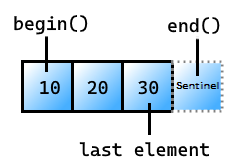values_view クラス (C++ 標準ライブラリ)
コレクション内の各タプルに似た値への 2 番目のインデックスで構成されるビュー。 たとえば、 std::tuple<string, int> 値の範囲を指定すると、各タプルのすべての int 要素で構成されるビューが作成されます。
values_view は elements_view<R, 1> のエイリアスであり、 std::unordered_mapなどの連想コンテナー内の値のビューを作成するのに役立ちます。
構文
template<input_range R>
using values_view = ranges::elements_view<R, 1>;
テンプレート パラメーター
R
基になる範囲の型。 この型は、 ranges::input_rangeを満たす必要があります。
特性の表示
以下の項目の説明については、 View クラスの特性を参照してください。
| 特徴 | 説明 |
|---|---|
| 範囲アダプター | views::values |
| 基になる範囲 | forward_range以上を満たす必要があります |
| 要素の種類 | 2 番目のタプル要素の型と同じ |
| 反復子カテゴリの表示 | forward_range、 bidirectional_range、または random_access_range |
| サイズ | 基になる範囲が満たされる場合のみ sized_range |
const対応 |
基になる範囲が満たされる場合のみ const-iterable |
| 共通範囲 | 基になる範囲が満たされる場合のみ common_range |
| 借用範囲 | 基になる範囲が満たされる場合のみ borrowed_range |
メンバー
| メンバー関数 | 説明 |
|---|---|
| コンストラクターC++20 | values_view を構築します。 |
baseC++20 |
基になる範囲を取得します。 |
beginC++20 |
最初の要素を指す反復子を取得します。 |
endC++20 |
values_viewの最後に sentinel を取得します。 |
sizeC++20 |
要素の数を取得します。 |
継承の対象 view_interface |
説明 |
backC++20 |
最後の要素を取得します。 |
emptyC++20 |
values_view が空かどうかをテストします。 |
frontC++20 |
最初の要素を取得します。 |
operator[]C++20 |
指定した位置にある要素を取得します。 |
operator boolC++20 |
values_viewが空でないかどうかをテストします。 |
要件
Header: <ranges> (C++20 以降)
名前空間: std::ranges
コンパイラ オプション: /std:c++20 以降が必要です。
解説
values_viewで使用できるタプルのような型は、std::tuple、std::pair、およびstd::arrayです。
コンストラクター
values_viewのインスタンスを構築します。
1) constexpr values_view(R base);
2) values_view() requires default_initializable<V> = default;
パラメーター
base
タプルに似た型の基になる範囲。
テンプレート パラメーターの型の詳細については、「 Template パラメーターを参照してください。
戻り値
values_view インスタンス。
解説
values_viewを作成する最善の方法は、values範囲アダプターを使用することです。 範囲アダプターは、ビュー クラスを作成するための目的の方法です。 独自のカスタム ビューの種類を作成する場合は、ビューの種類が公開されます。
- 指定したビューから
values_viewを作成します。 - 既定のコンストラクターは、既定で構築された
values_viewを作成します。
例: values_view
// requires /std:c++20 or later
#include <ranges>
#include <iostream>
#include <map>
#include <string>
#include <utility>
#include <vector>
int main()
{
// ========== work with a std::map
std::map<std::string, int> cpp_standards
{
{"C++98", 1988},
{"C++03", 2003},
{"C++11", 2011},
{"C++14", 2014},
{"C++17", 2017},
{"C++20", 2020}
};
// Extract all of the values from the map
for (int years : std::views::values(cpp_standards))
{
std::cout << years << ' '; // 2003 2011 2014 2017 1988 2020
}
std::cout << '\n';
// ========== work with a std::pair
std::vector<std::pair<std::string, int>> windows
{
{"Windows 1.0", 1985},
{"Windows 2.0", 1987},
{"Windows 3.0", 1990},
{"Windows 3.1", 1992},
{"Windows NT 3.1", 1993},
{"Windows 95", 1995},
{"Windows NT 4.0", 1996},
{"Windows 95", 1995},
{"Windows 98", 1998},
{"Windows 1.0", 1985},
{"Windows 2000", 2000}
};
// Another way to call the range adaptor using '|': create a keys_view from each pair
for (int years : windows | std::views::values)
{
std::cout << years << ' '; // 1985 1987 1990 1992 ...
}
}
2003 2011 2014 2017 1988 2020
1985 1987 1990 1992 1993 1995 1996 1995 1998 1985 2000
base
基になるビューのコピーを取得します。
// Uses a copy constructor to return the underlying view
constexpr V base() const& requires std::copy_constructible<V>;
// Uses a move constructor to return the underlying view
constexpr V base() &&;
パラメーター
なし
戻り値
基になるビュー。
begin
values_view内の最初の要素を指す反復子を取得します。
// returns a non-const iterator
1) constexpr auto begin() requires (!Simple_view<V>);
// returns a const iterator
2) constexpr auto begin() const requires ranges::range<const V>;
パラメーター
ありません。
戻り値
values_view 内の最初の要素を指す反復子。

end
の最後にセンチネルを取得します。 values_view
1) constexpr auto end() requires (!Simple_view<V> && !ranges::common_range<V>);
2) constexpr auto end() requires (!Simple_view<V> && ranges::common_range<V>);
3) constexpr auto end() const requires ranges::range<const V>;
4) constexpr auto end() const requires ranges::common_range<const V>;
パラメーター
ありません。
戻り値
内の最後の要素に続くセンチネル values_view

size
要素の数を取得します。
constexpr auto size() requires sized_range<V>
constexpr auto size() const requires sized_range<const V>
パラメーター
ありません。
戻り値
values_view にある要素の数。
解説
ビューのサイズは、基になる範囲が sized_range、つまり境界付きである場合にのみ使用できます。